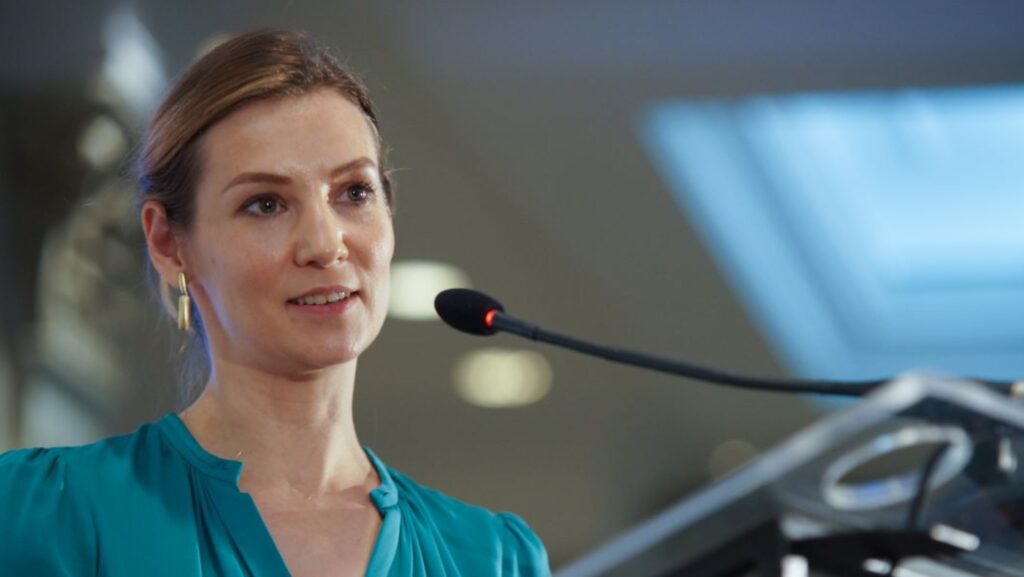From increased competition to contending with new systems and regulations – namely T+1 and ISO 20022 – the CSDs of today have a lot to deal with. Still, Anna Kulik, Secretary-General of the European Central Securities Depositories Association (ECSDA) believes that CSDs are equipped to embrace the challenges, barring matters of cooperation within the larger political and regional ecosystems in which they exist.
She spoke to PostTrade 360° on some of the most topical issues engaging the industry today, after a panel session at this year’s Sibos titled “Can securities market infrastructures march in step to ISO 20022?”
A slow start for ISO 20022
“Swift’s very first survey on whether to move to ISO 20022 for securities came back with a very clear ‘no’ from CSDs,” she recalls. “But today, the various reporting under different legislation are indeed all on ISO 20022. The new messages for the Shareholder Rights Directive (SRD) have been natively developed only with ISO2022 and as I mentioned on the panel, the communications of CSDs with the European Central Bank (ECB) are as well. More message types will be moving to 20022 with the implementation of Eurosystem Collateral Management System (ECMS) and Standards for Corporate Actions (SCoRE).”
According to Anna Kulik, the CSDs are more than ready for the 2030 deadline set for a full transition to ISO 20022 for corporate actions, general meetings, market claims, and shareholder identification. The speed of this transition, therefore, lies not in the CSDs’ preparedness, but in the hands of their clients. “We will accept communication in ISO 20022 and plan to decommission other standards for several domains as soon as the clients are ready.”
With ISO 15022 having coexisted in parallel with ISO 20022 for such a long time, the inertia to switch to the new system can be difficult to overcome. Nevertheless, there are motivations to do so. Referring to the translation boxes that are used when two parties are communicating through the two different standards, Anna Kulik says, “It’s a question of defining the right moment to switch and carefully and jointly with the industry planning for the elimination of the redundant costs of maintaining two standards instead of one. It is important that the post-trade industry considers the current trend and speaks about it sufficiently in advance, allowing all stakeholders to prepare for it in advance, particularly keeping in mind the busy IT release planning for the years to come.”
Maintenance is basic courtesy
“This is the ECSDA advice: until the deadline, keep both ISO 15022 and 20022 maintained and upgraded. It’s our recommendation to always be using the latest versions of the relevant standards – but we need to be pragmatic with this. Stopping the maintenance of the older standard may mean that there is no choice but to move to ISO 20022, or that the other party might not even be able to pass on messages.”
She concludes with a reminder: “The financial market is a network, an ecosystem. It’s fundamental to be as encompassing as possible. This is why we have also consulted the global community of CSDs, who at the World Forum of CSDs, have supported our recommendations to decommission 15022 for the proposed domains by 2030.”
All have to be on board
On the note of faraway deadlines, Anna Kulik touched on the discussion in some markets around an earlier move to T+1. She believes that the switch to the new standard is not indispensable for T+1, but is certainly future-proof, offering higher levels of efficiency and straight-throughs processing (STP) of post-trade processes that are necessary for the shortening of the settlement cycle.
“The priorities of the IT roadmaps need to be agreed upon sufficiently in advance, but the European community has not seen T+1 as a priority for post-trade in recent years. The need to further shorten the settlement cycle has not appeared to be part of reports on the Capital Markets Union (CMU) or barriers to post-trade,” she says.
“CSDs can process settlements based on the requested settlement cycle, including on the same day. We do not have major barriers that prevent the settlement process from being accomplished on T+1 in a single currency zone. However, settlement efficiency optimisation is fundamental to T+1, and therefore should be a precursor to it. Efficiency points need to be improved across the entire holding chain. Many processes are performed before the CSDs even enter into the game”.
She believes that the adoption of T+1 in Europe will be about “carefully balancing the positions and interests of the different stakeholders taking into account the risk of speeding up, and trying to decide on the priorities, and hence, deadlines that are truly helpful and in support of the European capital markets, in the current geopolitical context.”
“The fundamental decisions for the financial market plumbing, with impact on cross-border investment, such as setting the settlement cycle, should not be made by the regions unilaterally, but need to be discussed between the major market regulators at the global level,” she admits.
Making the right connections
Just as in the implementation of ISO 20022, the idea of interconnectivity within the financial market resurfaces in the T+1 discussion. “We are all globally connected so we cannot disregard the situation in the US,” Anna Kulik says.
“Indeed, many of the major players coming to Europe will already be on T+1 in the US, but we also need to think about how we will serve some of the markets that are in different time zones, and what the impacts on liquidity and FX will be. Within a shorter cycle, the Asian investors may need to advance funds to deliver both securities and cash on time.”
“We have to make sure that the reduction of the cycle for financial transactions processing leads us to global financial markets that are as safe as they were before T+1,” she adds.
Healthy competition
The talk of harmonisation and emphasis on interconnectivity follows an ambition to promote a vibrant culture of competition between the CSDs in the region. Pointing out that the idea was originally seeded with the Central Securities Depositories Regulation (CSDR), Anna Kulik says that “major steps have been made in the right direction, although we cannot yet speak about a completely free competition and a possibility to fully consolidate CSDs cross-borders”.
“A part of this has been enabled. CSDs can now attract issuers from different countries, offering access to participants from another EU member state and foreigners. In some cases, they may even request a connection to the central bank of another EU jurisdiction, creating the possibility for participants to use the central bank money in another member state,” she explains. “But participants and issuers are not solely driven by the adequacy and sophistication of the CSD service offering. In addition, CSDs are not free to fully consolidate their different engines under a single securities settlement system. The level of consolidation and possible related efficiency gains are still frequently stopped by jurisdictional borders.”
A united front
“What I’m getting at is that we not only need to take into account the CSDs’ aspiration for competition and consolidation, but should also embrace a certain level of jurisdictional challenges. Fundamental changes for us to move into a more efficient and truly single CMU will not happen without political will.”












